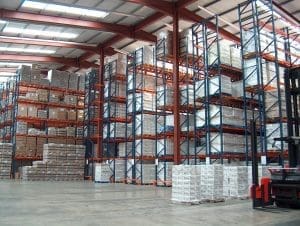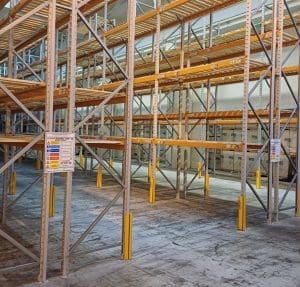
Advanced Handling & Storage Ltd
The Pallet Racking People

Key Insights on Securing Pallet Racking to Walls, Floors, and Determining Necessary Bolts
When you’re sprucing up your warehouse to boost both its efficiency and safety, it’s crucial to get to grips with the best ways to secure your pallet racking. In this blog post, we’ll explore the must-knows for anchoring your racking systems properly, making sure they stand strong under the pressures of daily operations while keeping everyone safe and sound.
Should pallet racking be bolted to the wall?
This question is fundamental to setting up a secure racking system. Our advice is that bolting pallet racking to walls is unsafe, as should an accident occur where the pallet racking were to fall, it could result in the pallet racking bringing the walls down in your warehouse.
How far does pallet racking need to be from the wall?

Maintaining proper clearance between pallet racking and the wall is essential for safety, access, and ventilation. The recommended distance can vary depending on factors such as the type of goods stored and the equipment used. A general rule is to allow at least 6 inches (15 cm) of space between the wall and your racking system. This space helps in preventing damage to both the racking and the wall and facilitates proper air circulation, pest control, and fire safety measures.
How do you secure pallet racking to concrete floor?
Securing pallet racking to a concrete floor is a critical step in ensuring the safety and integrity of your storage system. This is typically achieved by using anchor bolts designed for concrete applications. The process involves drilling holes into the concrete, aligning the racking feet, and then securing them with the bolts. It’s important to use the right type and size of anchor bolts, as specified by the racking manufacturer, and to ensure they are installed to the correct depth and torque.
How many bolts does racking need?
The number of bolts required for securing each upright of your pallet racking will depend on several factors, including the height and capacity of the racking, the type of floor, and the environmental conditions such as seismic activity. Typically, each upright should be anchored with at least two bolts, but for heavier-duty applications or higher racking, more may be necessary. It is vital to refer to the manufacturer’s recommendations and any applicable safety standards to determine the appropriate number and size of bolts.

Conclusion
Making sure your pallet racking is well-secured isn’t just about ticking boxes for regulations; it’s a key part of keeping your warehouse safe and ticking over smoothly. Whether you’re setting up new shelves or checking over the ones you’ve got, it’s really important to make sure everything is anchored securely, there’s enough room around them, and you’re using the right amount of the right kind of bolts. This not only keeps your workspace safe but also makes sure everything runs like clockwork. If you’re ever unsure, remember it’s a great idea to chat with experts and follow the tried-and-tested methods. Feel free to get in touch at any time – we’re here to help you make sure your pallet racking is as safe and efficient as can be, keeping your operations seamless and secure.